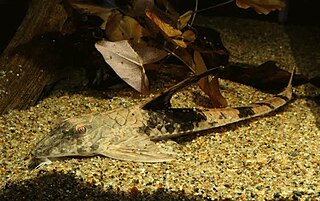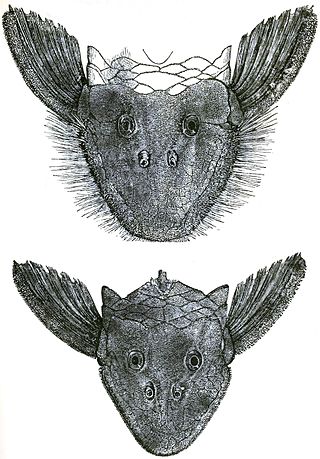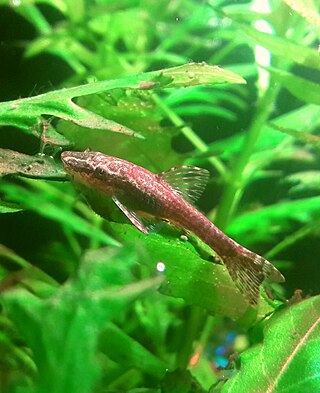
Loricariidae is the largest family of catfish, with over 90 genera and just over 680 species. Loricariids originate from freshwater habitats of Costa Rica, Panama, and tropical and subtropical South America. These fish are noted for the bony plates covering their bodies and their suckermouths. Several genera are sold as "plecos", notably the suckermouth catfish, Hypostomus plecostomus, and are popular as aquarium fish.

Hypostomus is a genus of catfish in the family Loricariidae. They are native to tropical and subtropical South America. H. plecostomus is the popular freshwater aquarium fish formerly known as Plecostomus plecostomus. The taxonomic structure of the Loricariidae is still being expanded by scientists. Hypostomus is a highly species-rich and widely distributed catfish genus.

Otocinclus is a genus of catfish in the family Loricariidae native to South America, commonly known as "dwarf suckers" or "otos". This genus, like other loricariids, is characterized by rows of armour plating covering the body, as well as the underslung suckermouth. They are generally small in size; O. tapirape is the smallest of the species (2.4 cm), while O. flexilis is the biggest (5.5 cm). These species have adaptations that allow them to breathe air. A duct forms at the junction between the esophagus and the stomach and expands into an enlarged, ring-like diverticulum, characteristic of this genus, which allows air-breathing. Otocinclus are popular aquarium fish, and they are often purchased as algae eaters. It is difficult to breed them in captivity, and only wild caught Otocinclus are available to hobbyists. This genus is widely distributed east of the Andes of South America, throughout the lowlands from northern Venezuela to northern Argentina, but are generally absent from the Amazon and the Orinoco lowlands.

Pseudancistrus is a genus of suckermouth armored catfishes native to South America.

Otothyropsis is a genus of armored catfishes native to South America.

The Hypoptopomatinae are a subfamily of catfishes of the family Loricariidae, composed of 17 genera and approximately 80 species. This subfamily represents about one-tenth of all loricariid species.
Hisonotus is a genus of armored catfishes native to South America. Species of Hisonotus and Curculionichthys are the only representatives of the subfamily Otothyrinae having serrae on the posterior edge of the pectoral fin spine. These species are small fishes, generally found in small fast flowing streams, where they grasp to the branches and leaves of aquatic or subaquatic plants. The species of this genus mostly occur in Atlantic coastal streams of southern Brazil and the Paraguay-Paraná system of southern South America. They are also distributed in the Río de La Plata basin and coastal rivers of southeastern Brazil.
Neoplecostominae is a subfamily of South American catfishes of the family Loricariidae. Species of this subfamily live in high-mountain and swift-flowing river habitats.

The Hypostominae are a subfamily of catfishes of the family Loricariidae. Most members are restricted to tropical and subtropical South America, but there are also several species in southern Central America. Hypostomus plecostomus, which is popular in the aquarium trade, has been introduced to several regions far from its native range.

Parotocinclus is a genus of fish in the family Loricariidae native to South America. This genus is distributed through almost all hydrographic systems in South America from the Guyana Shield drainages and Amazon Shield tributaries to the coastal drainages of eastern and southeastern Brazil, including the rio São Francisco basin. Most species have the caudal peduncle oval in cross section. It has been found that Characidium species may interact with P. maculicauda. The small Characidium will follow grazing P. maculicauda, which release particulate matter dislodged from the catfish's foraging.
Pseudotocinclus is a genus of armored catfishes native to South America.
Corumbataia britskii is a species of armored catfish endemic to Brazil. It is found in small tributaries of the Sucuriú River, upper Paraná River Basin in the state of Mato Grosso do Sul. This species was found in deforested areas in moderate to fast current streams. It is associated with aquatic macrophytes or the submerged portion of marginal vegetation. In its gut contents were found filamentous blue-green algae, chlorophytes, diatoms and bark. This species grows to a length of 2.7 centimetres (1.1 in) SL.
Pseudotocinclus parahybae is a species of armored catfish endemic to Brazil, where it is known only from the type locality, a tributary of the ribeirão Grande, rio Paraíba do Sul basin. It is a medium-size creek, 0.5–1.5 metres (1.6–4.9 ft) deep and 5.0 m (16.4 ft) wide at approximately 800 m (2600 ft) above sea level, on the slope of Serra da Mantiqueira, with very clear, well oxygenated, and fast flowing water, running mainly on stone beds.

Rhinolekos is a genus of armored catfishes native to South America. This genus is only known from the Tocantizinho River and Paranaiba River drainage in Goiás, Brazil.
Scott Allen Schaefer is an American ichthyologist working at the American Museum of Natural History as the dean of science for collections, exhibitions, and the public understanding of science; he serves as the curator-in-charge, in the department of ichthyology, within the division of vertebrate zoology.
Curculionichthys coxipone is a species of catfish in the family Loricariidae. It is native to South America, where it occurs in the drainage basins of the Cuiabá River and the Paraguay River. It reaches 3 cm SL. The species was described in 2015 by Fábio Fernandes Roxo, Gabriel Souza da Costa e Silva, Luz E. Orrego, and Claudio Oliveira, alongside the description of the genus Curculionichthys to include several species formerly classified in the genus Hisonotus.

Curculionichthys insperatus is a species of catfish in the family Loricariidae. It is native to the Paraná River drainage in Brazil, where it inhabits streams near banks covered with partially submerged vegetation. It reaches 3 cm standard length. This species was formerly classified as a member of the genus Hisonotus, although it was moved to the then-new genus Curculionichthys in 2015.
Curculionichthys sabaji is a species of catfish in the family Loricariidae. It is native to the Xingu River basin in Brazil. The species reaches 2.4 cm SL. It was described in 2015 by Fábio Fernandes Roxo, Gabriel Souza da Costa e Silva, Luz E. Orrego, and Claudio Oliveira, alongside the description of the genus Curculionichthys to include several species formerly classified in the genus Hisonotus.

Curculionichthys sagarana is a species of catfish in the family Loricariidae. It is native to South America, where it occurs in the drainage basins of the Das Velhas River and the São Francisco River. It reaches 2.4 cm SL. The species was described in 2015 by Fábio Fernandes Roxo, Gabriel Souza da Costa e Silva, Luz E. Orrego, and Claudio Oliveira, alongside the description of the genus Curculionichthys to include several species formerly classified in the genus Hisonotus.
Parotocinclus dani is a species of catfish in the family Loricariidae. It is native to South America, where it occurs in tributaries of the Tapajós basin in Brazil.











